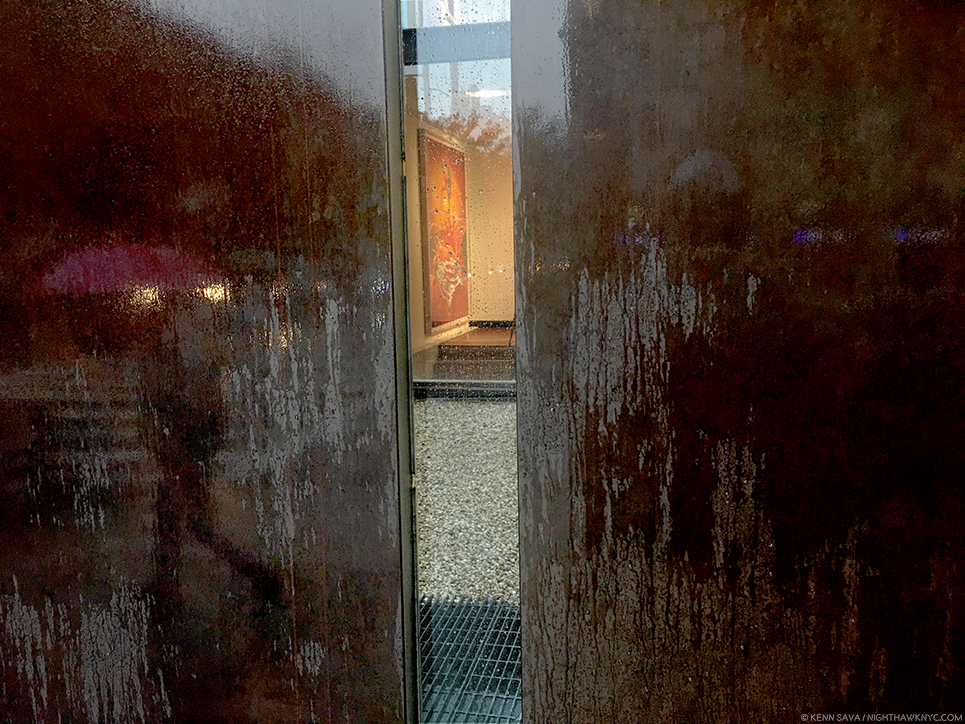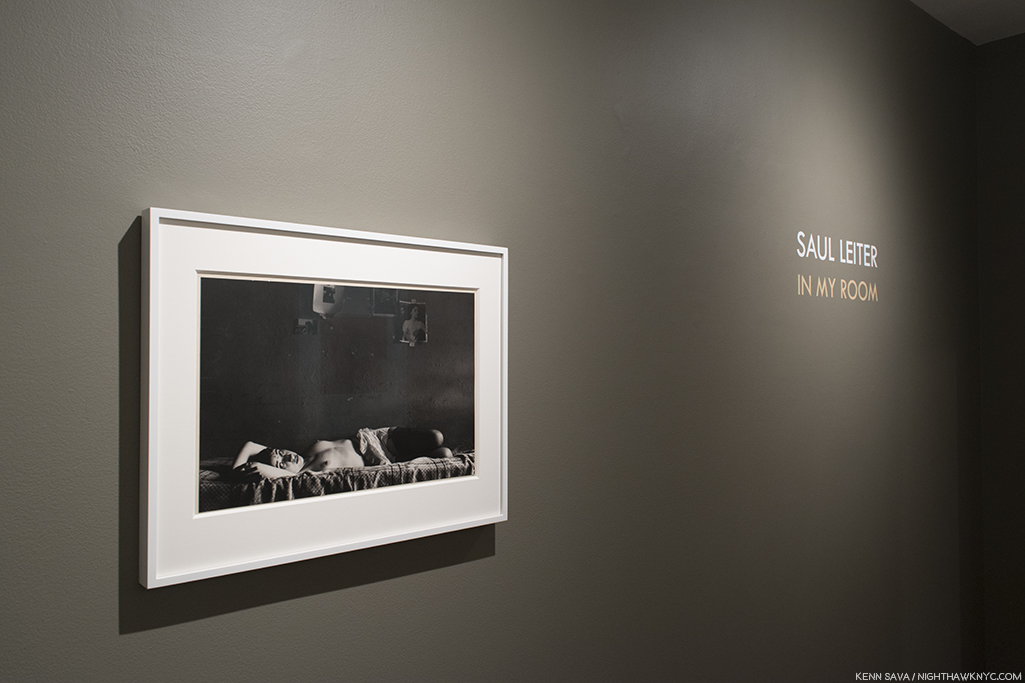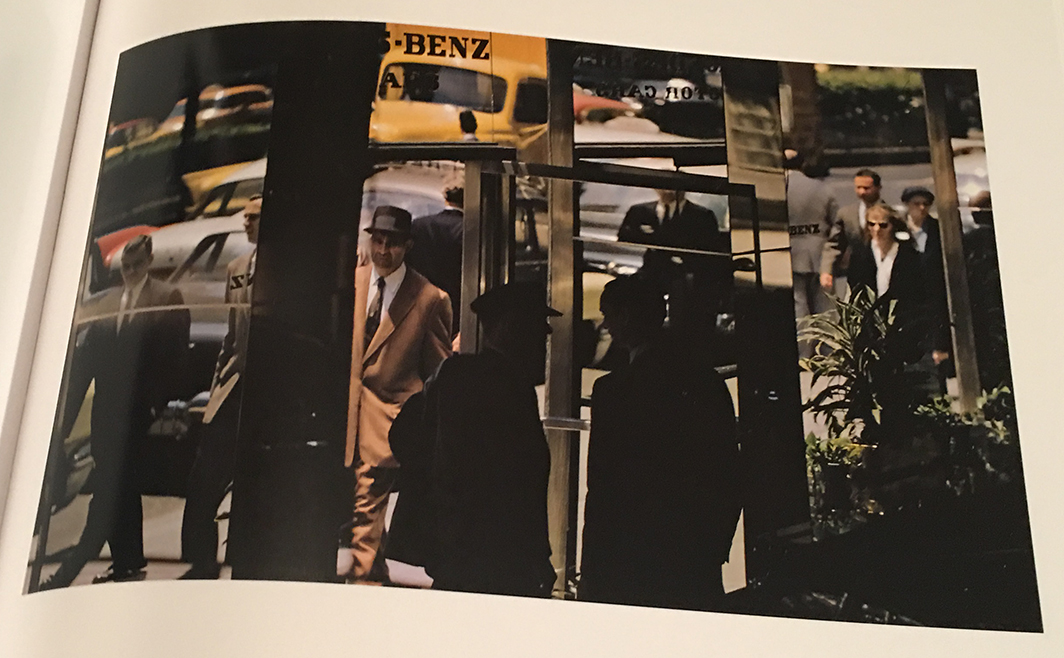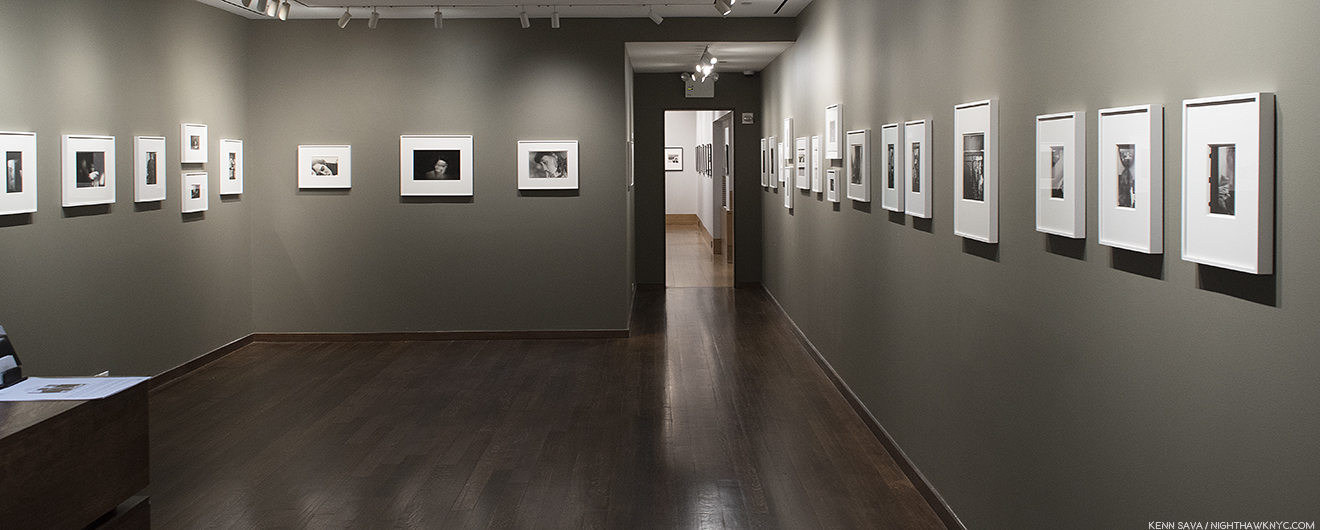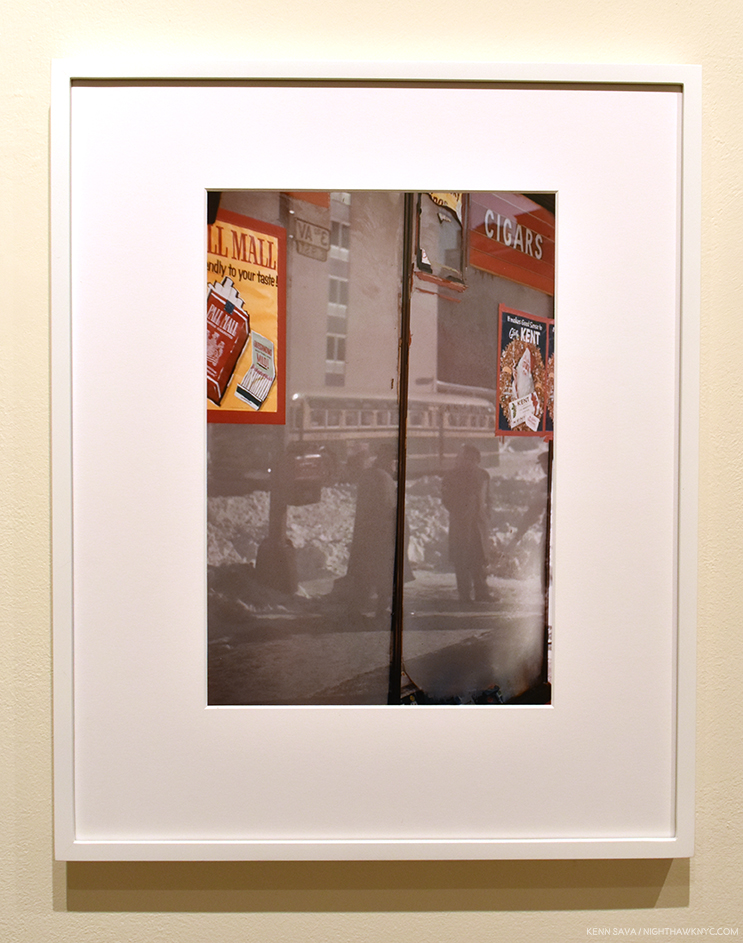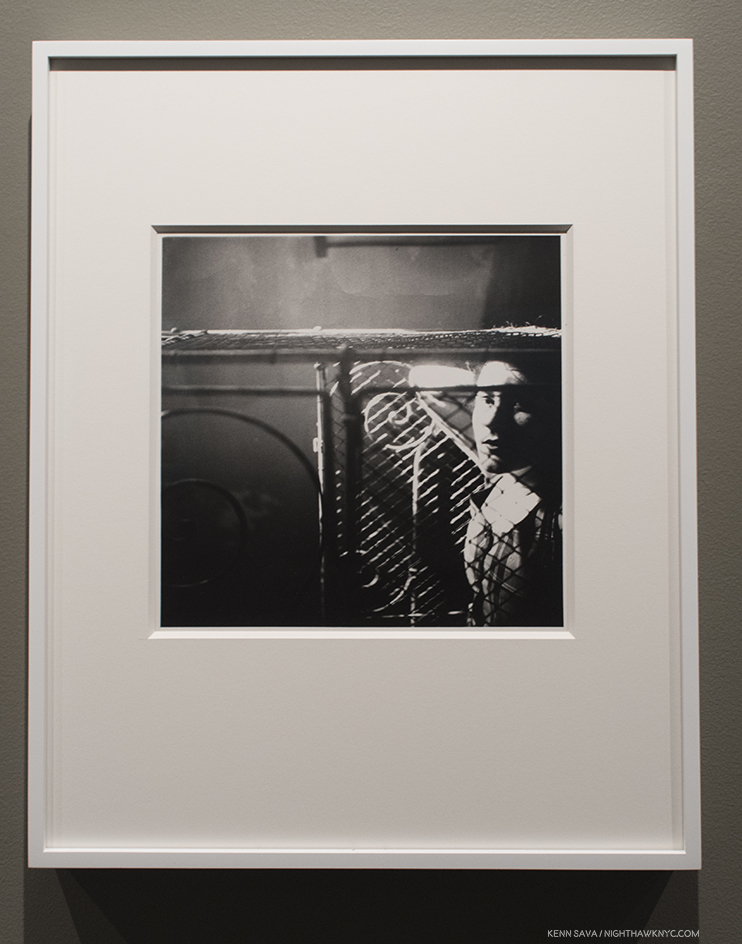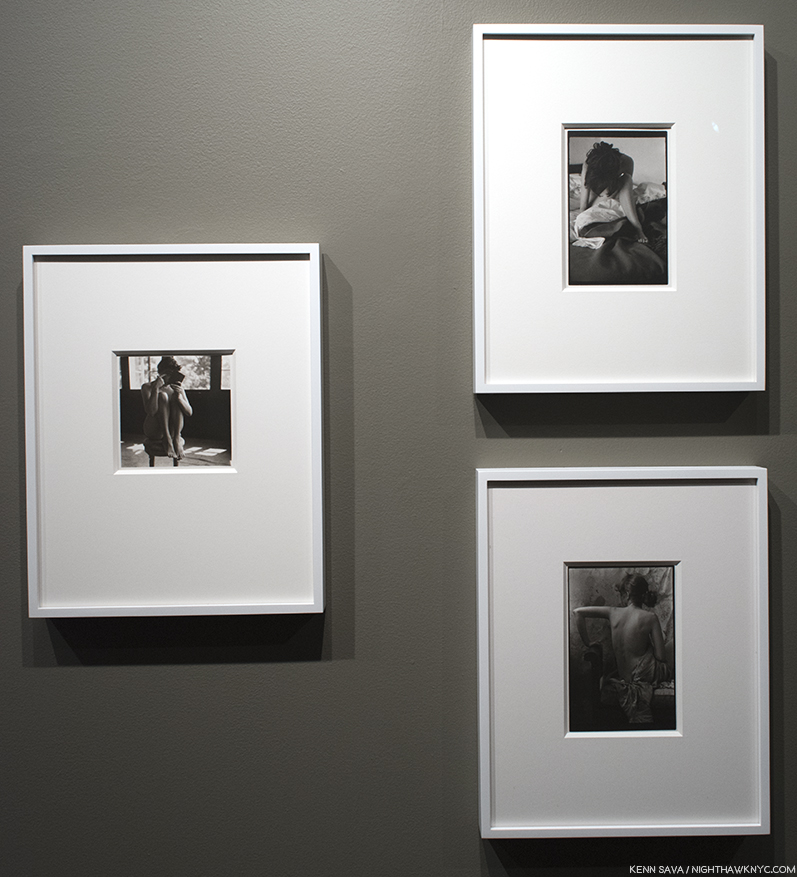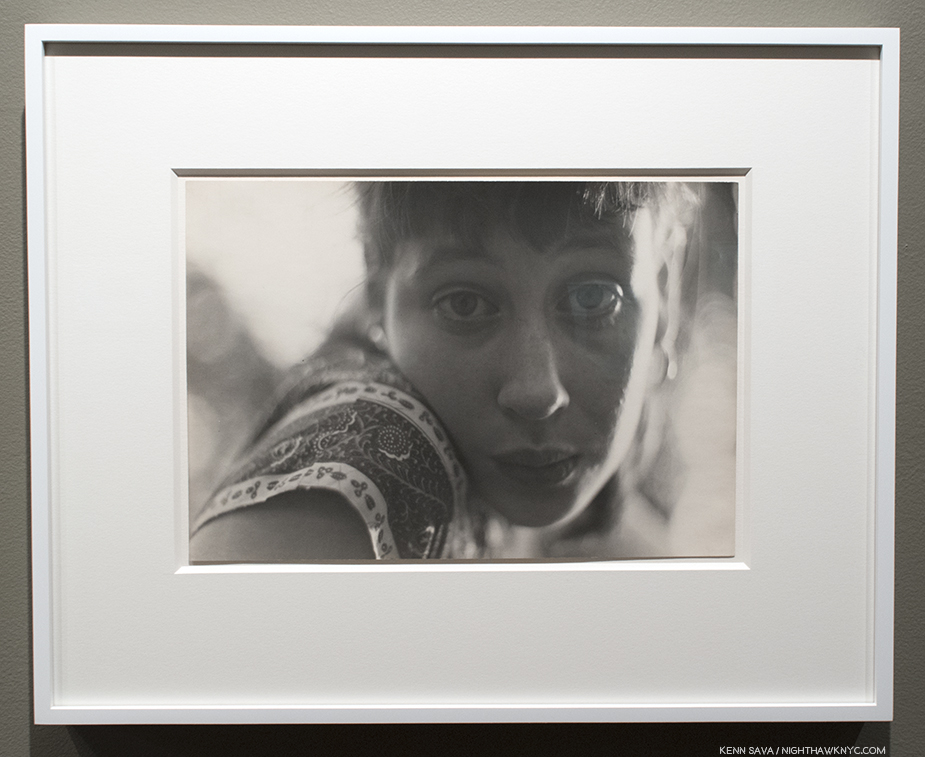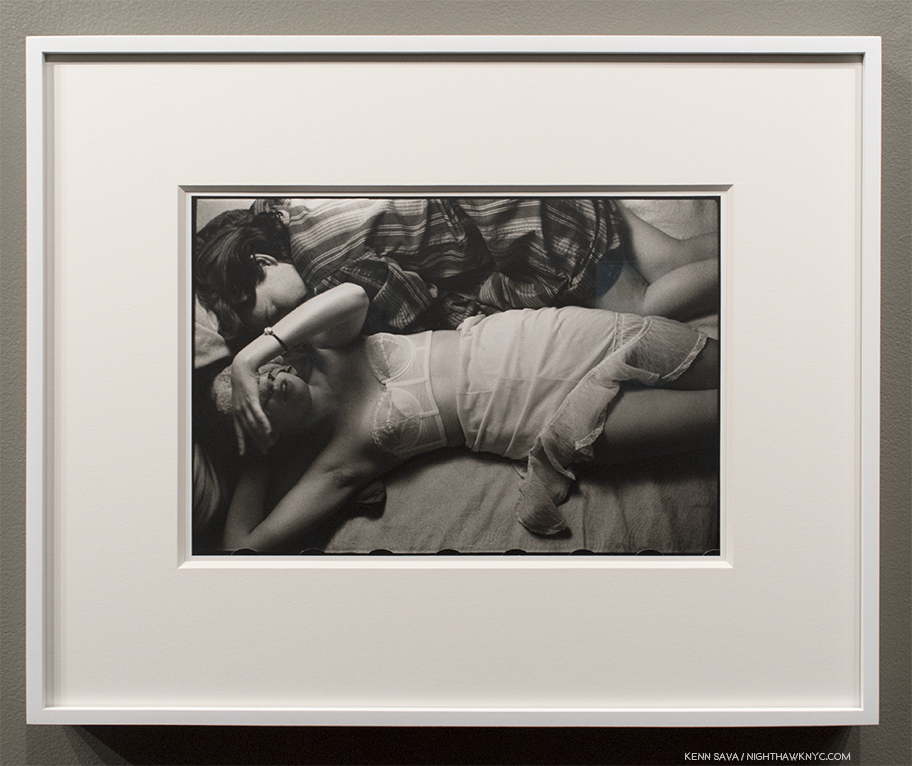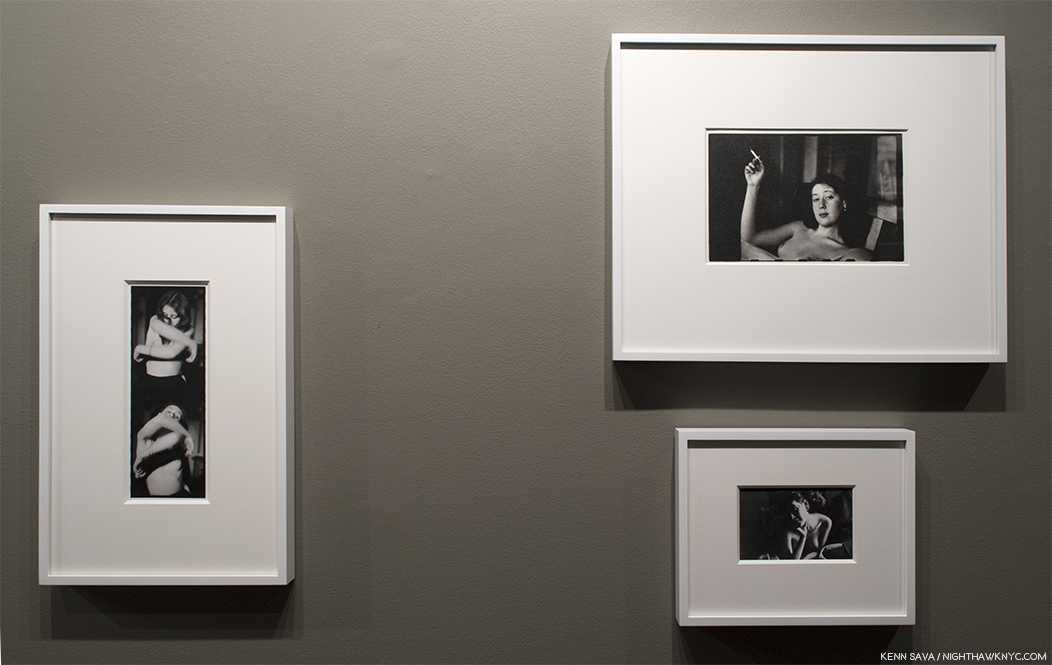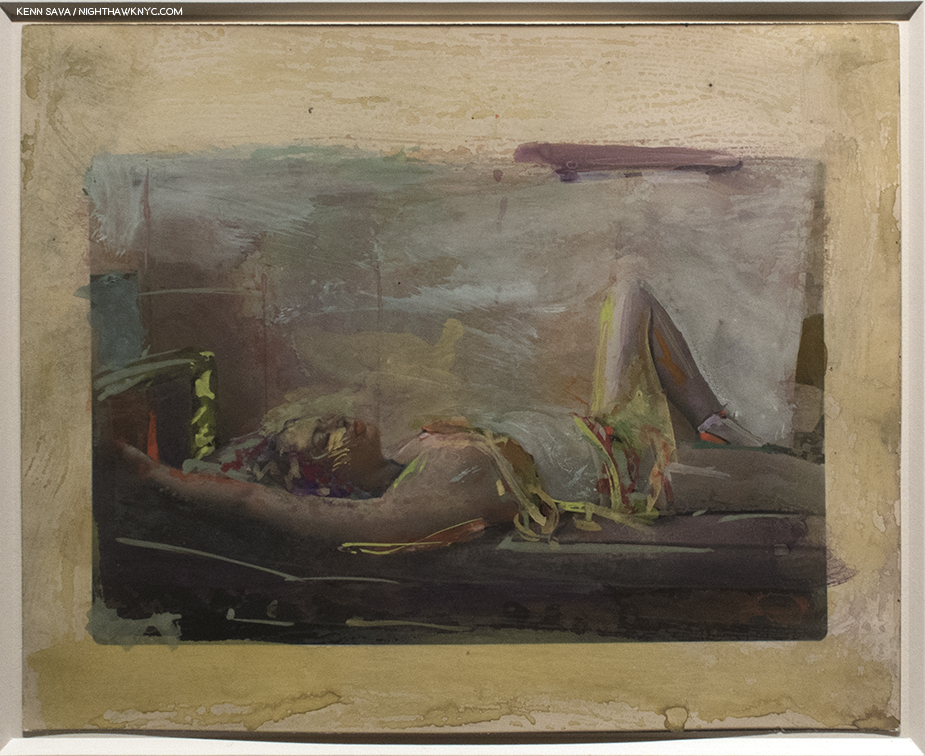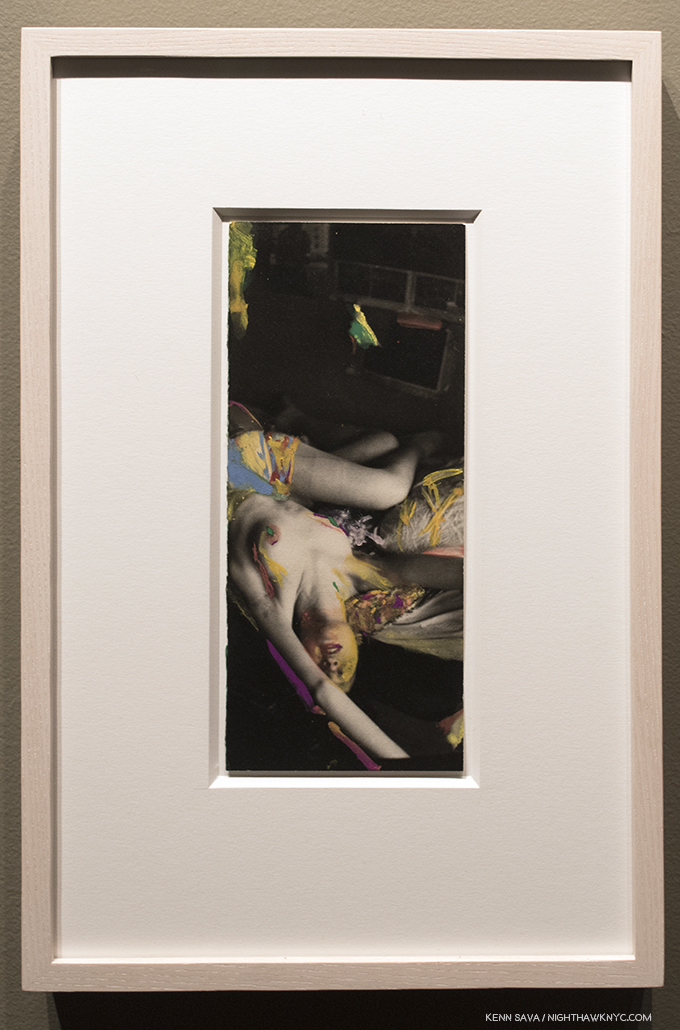Written & Photographed by Kenn Sava (*unless otherwise credited)
One of the few good things about being out on a rainy day is that I use the opportunity to look around and see if I can see a “Saul Leiter.” Maybe the rain is being reflected off the pavement glistening in some unusual shade of neon, or a bright red umbrella will slice through the grey air unexpectedly, or I’ll see shapes abstracted through a misty cab window and try to figure out what they are…the possibilities are seemingly endless…
Given how popular Saul Leiter has become, I doubt I’m the only one who does this.
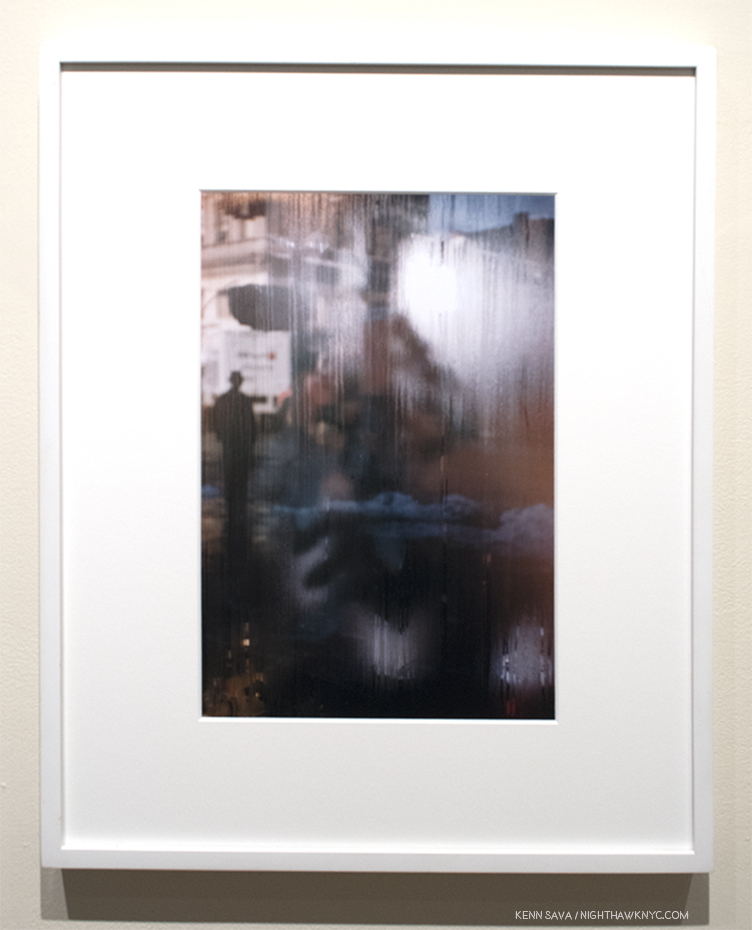
Street Scene, 1959, by Saul Leiter, seen at the Howard Greenberg Gallery Viewing Room. Saul Leiter started out to be a Painter. To my eyes, works like these brilliantly walk the line between abstraction and realism, showing how abstraction is all around us in the “real world,” in ways, perhaps, only Ernst Haas was doing at the time, among Photographers. Meanwhile the “New York School” of Abstract Expressionists, including his friend, Richard Pousette-Dart, was revolutionizing Painting.
Of course, Saul Leiter (1923-2013) was able to make great Photos in any light, and included among them, he struck me as having a unique way with inclemency. It’s just one way that he’s impacted the way I see the world. For those who love Saul Leiter’s work, too much of it is never enough. So, the chance to see more is an event. Recently, two such chances appeared- a show at Howard Greenberg Gallery, which was accompanied by the release of a new Steidl book, both titled In My Room.
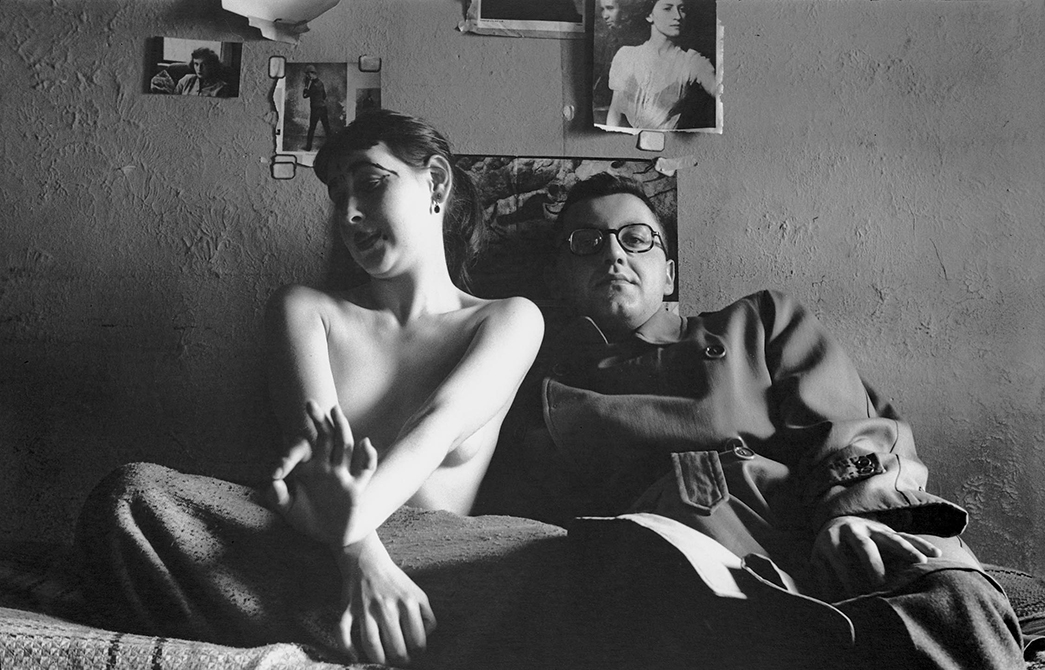
Self-Portrait with Inez. The first Photo in the book and the only time the Artist appears in it. *Photo courtesy the Saul Leiter Foundation and Steidl.
They center around a body of work that almost no one saw during the Artist’s lifetime, a collection of “intimate” Photographs taken of his female friends, often in various stages of dressing/undress. The show adds a second body of seldom seen work, Saul Leiter’s “Painted Nudes,” works that consist of black & white prints from the “intimate” series that he then hand Painted. First shown in the U.S. in 2014, to date they are the only body of Saul Leiter’s Paintings we’ve gotten to see. Having only seen them in the book “Saul Leiter: Painted Nudes,” which was released in 2015, this was my first time seeing some of them in person.
Saul Leiter took thousands of nude Photographs of his friends and lovers between about 1947 through the early 1970s. Perhaps the first thing that’s interesting about them is they’re in black & white, though he worked exclusively in color during most of that period. Why are these then in black & white? The best theory I’ve heard is that he was able to develop and print them in his home darkroom, and could, therefore, keep them private. As a result, almost no one saw them. One of the few who did was his former art director at Harper’s Bazaar, Henry Wolf, who wanted to publish a selection of them as a book in the 1970’s. It didn’t come to pass then. By this point, Saul Leiter had fallen into eclipse. A total eclipse that had him completely out of the view of the public.
“I spent a great deal of my life being ignored. I was always very happy that way. Being ignored is a great privilege. That is how I think I learned to see what others do not see and to react to situations differently. I simply looked at the world, not really prepared for anything1.”
He got his wish, but It wasn’t always so.
The great Photographer Edward Steichen, then Director of Photography at MoMA2, included 5 works by Saul Leiter in his 1953 group show, Always the Young Stranger, the title a line borrowed from Carl Sandburg, who the show was intended as a 75th Birthday tribute to. He subsequently went on to a long career in fashion working for some of the most renowned publications of the time, until one day, he walked away, fed up with the micro-management that had crept into his shoots. He was rarely seen again until Steidl released the instant classic, Saul Leiter: Early Color, in 2006, launching the Saul Leiter renaissance. Now in its 8th edition, Early Color was followed by Early Black & White, in 2014, a year after Saul Leiter passed away, a week short of his 90th birthday. Now, In My Room brings Henry Wolf’s idea full circle. It’s dedicated to him.
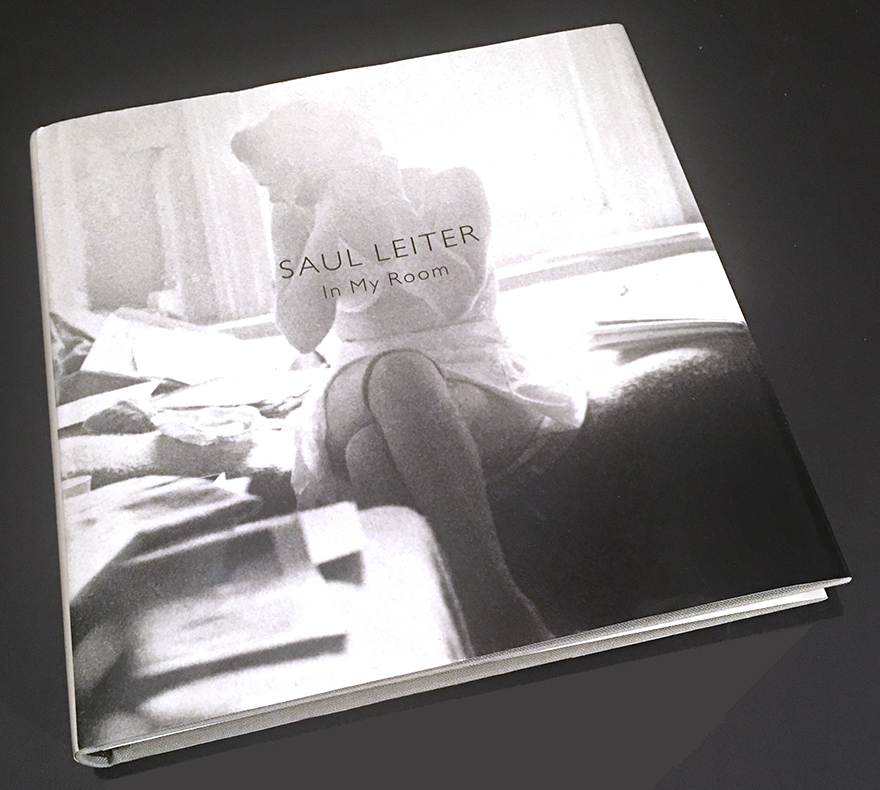
Saul Leiter: In My Room, just published by Steidl. 148 pages, 81 images.
Saul Leiter is often referred to as “a pioneer of color Photography.” What, exactly, do they mean? Apparently he, too, was puzzled. “I’m supposed to be a pioneer in color. I didn’t know I was a pioneer….,” he told Time Magazine, in 2013. Fascinated by the history of color in Photography, I’ve spent most of this year researching it, which may help me understand what they mean. The story of color in Fine Art Photography is one that has only gradually, and relatively recently, been coming more to light. So entrenched has black & white Photography been in the Art world, that it seems that many Photographers kept their color work to themselves, when it wasn’t commissioned for magazines. It makes me wonder- if color film had been invented first, would black & white still have dominated? Maybe in media where color printing/reproducing technology hadn’t yet been invented, but in the world of Art? I wonder. In the world of Painting, even going back to ancient times, the Artist was working in color. Interestingly, Drawings (which are most often in pencil, and hence, in black & white) are often seen and still treated as “preliminary works” to something more “finished,” even when they ARE the final work. A preference for black & white imagery exists nowhere else in the world of Art besides the place it held in Photography until the 1970s.
Meanwhile, Steichen in Color Portraits, Fashion & Experiments by Edward Steichen shows the aforementioned Edward Steichen’s color images from 1908!, on. Jacques-Henri Lartigue began making color images in 1912. Ansel Adams was making color images in the 1940’s, as was Keld Helmer-Petersen, who’s book Keld Helmer-Petersen: 122 Colour Photographs: Books on Books No. 14
, released in 1948, will astound lovers of William Eggleston and Stephen Shore. Eliot Porter was making them in the 1950’s…And then there is Ernst Haas. It was Ernst Haas, and NOT William Eggleston who was given the FIRST show of color Photographs ever at MoMA in 1962, a full 14 years before Photographs by William Eggleston!, and its classic accompanying catalog William Eggleston’s Guide
, finally marked the beginning of the acceptance of color Photography into the world of Fine Art Photography. Haas’ abstract works of the 1950’s on were seen in the terrific Steidl book, Ernst Haas: Color Correction: 1952–1986
, that reveals another side of the Artist, one who loved abstraction, that stands in contrast to the somewhat staid image many had, and still have, of Ernst Haas. In fact, the image just above is not by Saul Leiter. It’s New York City, USA, 1953, by Ernst Haas, from Color Correction! There are, no doubt, others who will still come to light, as Fred Herzog, who also took color Photos of Vancouver in the 1950’s, has more recently (Mr. Herzog is an admirer of Saul Leiter’s). Helen Levitt Photographed NYC in color in 1958-9, but, unfortunately, most of those images were lost in a fire. She later went back out and shot the images included in the terrific book, Slide Show: The Color Photographs of Helen Levitt
.” So? Saul Leiter was one of the first Photographers to take color Photographs on the streets in NYC, and so, he is a pioneer, though he is not a “street Photographer” like Robert Frank or Garry Winogrand3. His was an Artist’s eye, and that’s on view in all of his work, inside and outside of his Apartment, in Photography and in Painting, and, in my view, has a difference effect than street Photography does.
“They’re people who are driven by the notion…they sacrifice everything for success. I didn’t feel that way. I attached more importance to the idea that there might be someone who might love me and who I might love4.”
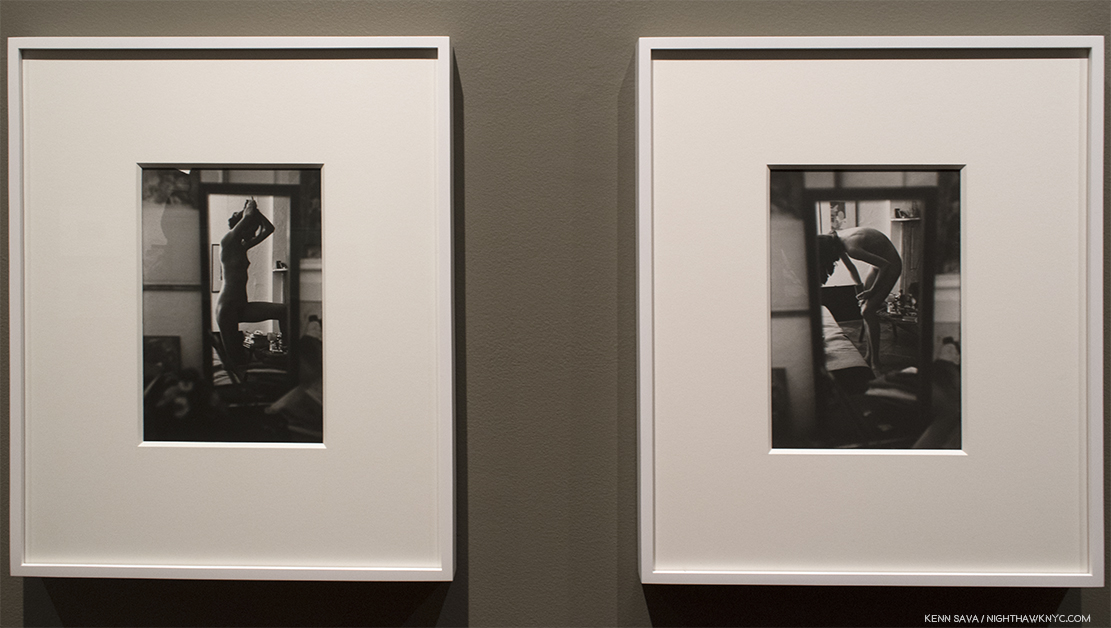
Both works are titled Soames, c.1960 featuring his long time lover and partner, the Artist Soames Bantry. Perhaps as close as Saul Leiter got to finding that person. A number of these images take advantage of furnishings, windows, or items in the apartment. Here both shots feature the same mirror.
I had those words in my mind as I walked through “In My Room” at Howard Greenberg. I’m not sure there’s really any other way to look at these images. Yes, we see them as “Fine Art” now, but back then they were among the most personal images Saul Leiter ever created, and his statement, above, speaks as much to what may have been one his mind in creating them as anything else I’ve read does. In the new Steidl book, the images are not captioned or dated, and the subject is not identified. And so, the book becomes a sort of scrapbook of intimate moments Saul Leiter shared with these women- lovers, and friends who felt comfortable being nude with him.
As such, they’re intimate beyond the nudity. The women, obviously, feel free to be themselves while the Artist approaches taking their pictures in ways that will look familiar to those who know his color work, where it often feels like he is almost eavesdropping on his subject. Here, and in the book, it feels as if he is always watching them. But, it’s not mutual. by my count of the images in the book, out of 81, only in 14 do the women make eye contact with him, in 18 they appear to be asleep, and in a further 11 they’re awake but lying down. In 44 they are nude or topless. Abstraction plays a lesser role here compared with his more familiar color work, but it’s here in the unusual camera angles he uses, and in seeing his subject through doors, furniture, or in mirrors. But posing is never going on here. The natural postures are striking, completely unlike anything you’d find in texts about Drawing or Painting from live models. This is particularly fascinating given that Saul Leiter was, also, a Painter who revered Vermeer5.
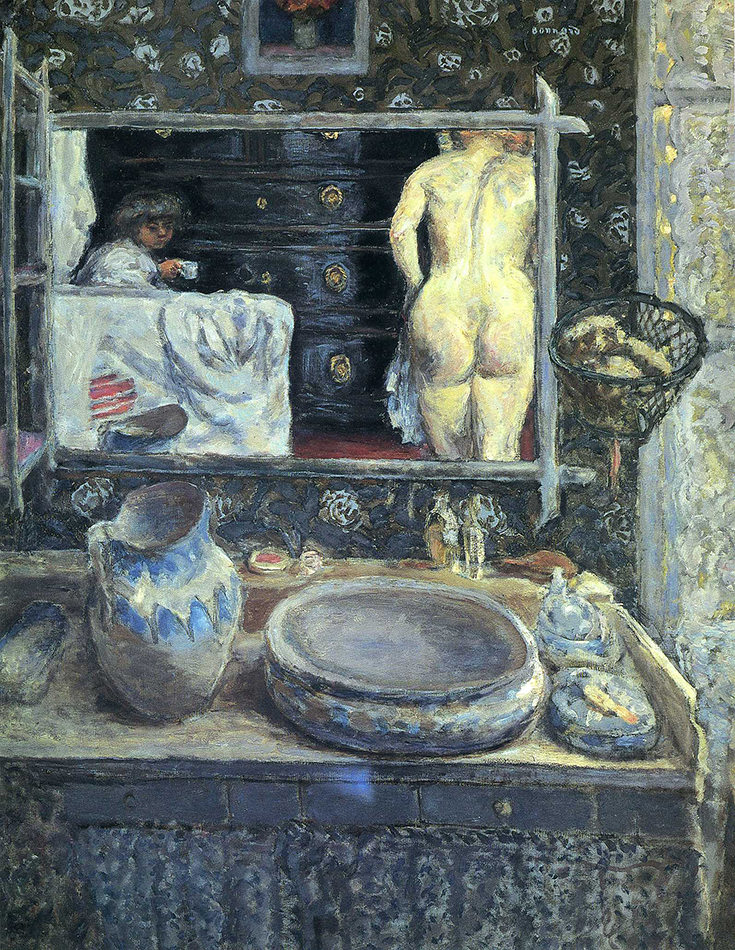
Pierre Bonnard, Mirror on the Wash Stand, 1908, Oil on canvas. Early on, Bonnard was a founding member of the avant-garde group Les Nabis. *Unknown Photographer.
Roger Szmulewicz, Director of Gallery Fifty-One, Antwerp, who have represented Saul Leiter, and now his Foundation, since at least 2008 (Howard Greenberg Gallery, who have been showing Saul Leiter since at least 2006, is the other representative of the Saul Leiter Foundation), said, “The influence of his Painting on his Photographs is made apparent when the two are present side by side6.” As they are in this show, though the Paintings are not his “pure” Paintings, but created on existing Photographs. When I look at these works side by side (the Photos and the “Painted Nudes”), it is possible to see the influence of another of his favorite Painters, Pierre Bonnard (1867-1947). Saul Leiter was 24 when Bonnard passed away. There was a posthumous exhibition of Bonnard’s work at MoMA in 1948 with over 150 items, 2 years after Saul Leiter moved to NYC from Pittsburgh to become a Painter, so it’s possible he saw it. Interestingly, these “intimate works” seem to begin around 1947, shortly after he began taking Photographs.
Saul Leiter’s color work is renowned for the astonishing way he uses color, but it seems to me that it’s equally impressive for his breaking of the “rules of composition.” His subject will be seen off center, or not complying with the “rule of thirds,” or be in shadows (even partially obscured as above), behind or visible through an object, window or mirror in the foreground. Sometimes, these foreground hindrances act as “curtains,” perhaps, a distant echo of Vermeer’s use of curtains.
Most intriguingly for me, Saul Leiter, like William Eggleston, Henri-Cartier Bresson and others, is another great Photographer who was also a Painter. My opinion is that being a Painter played an important role in the impact of their Photography, and is very possibly a reason why their work “looks different” from many other Photographers. When I see a Leiter or an Eggleston, it often feels to me that they are doing things they don’t do with Paint. Focusing on a detail that would seem to be too slight or unimportant for a whole Painting, or capturing a fleeting moment when light, setting and people are aligned for a split second. Or, in his “intimate” indoor work, capturing postures that are rarely seen in Paintings, perhaps, because they can’t be held long enough.
Saul Leiter is not often thought of as a portraitist, but he did them over his long career7. The portraits included here are beautiful, typically different but wonderfully evocative.
The lighting in these works is the natural light coming in through the large windows or the electrical lights in his apartment. No flash or extra lights.
All in all, the “intimate” series presents a remarkable tour de force of possibilities, of living in the moment, and of working creatively with whatever that moment presents to you, which is, of course, exactly what we see him capturing outside on the street in Early Color, but minus the personal element, which is entirely absent there. Those subjects are not connected, either to each other or to the Photographer. Here they are.
We’re told going in that these women are lovers and friends of Saul Leiter, though it might be hard to see that in these works. The Artist appears with one of the women in only two Photos (one in the show, and one in the book). There is no interaction beyond an occasional glance. There is comfort, obviously, but nothing is being done together. There is affection, but no romance or anything more. And so, when all is said and done, the overriding feeling I come away with is a sense of isolation on the part of the subject and the Photographer.
To outsiders, these Photos show the relaxed, natural beauty of his friends, in studies and portraits of them in the moment, and moment to moment. Though they are “intimate,” no love or physical intimacy is taking place in them. Maybe it already has, or is about to, and what we’re seeing in a number of these works is the moments after, or before. A number of the Photos in the show are not in the book. Whatever the case may be, since he knew these women, they are momentos of intimacy, and possibly, momentos of moments where that search for “someone who could love me” was close at hand, proof that it WAS possible to find.
Then, there were the “Painted Nudes.”
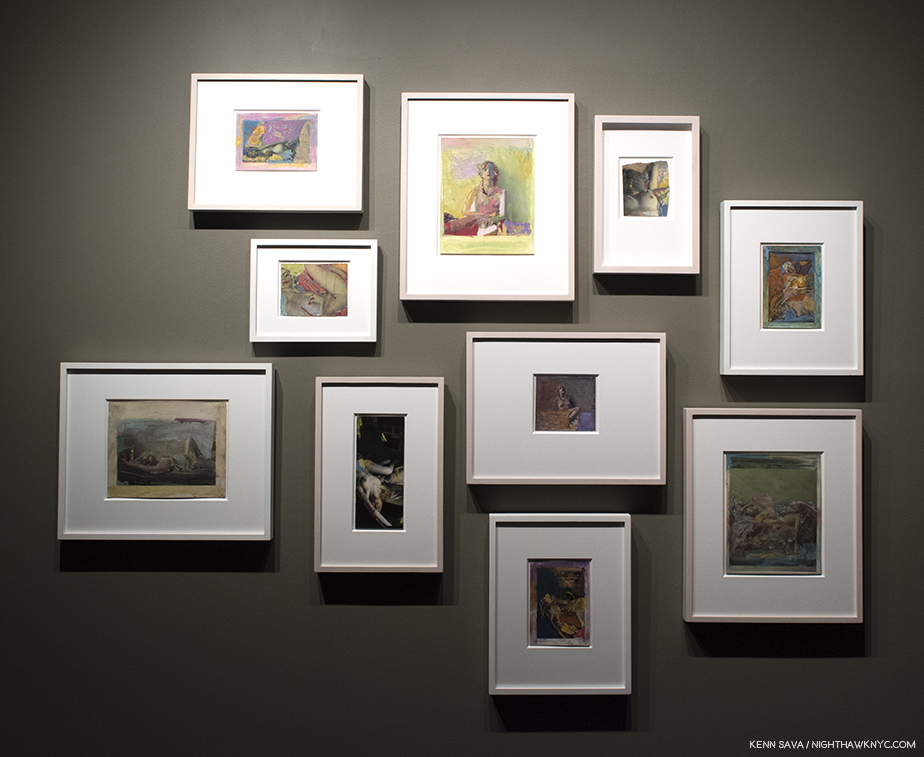
A selection of works from the “Painted Nudes” group. All of these works are gouache, casein and watercolor on silver gelatin paper.
The “Painted Nudes” are often revelations. They look like nothing else I’ve seen. Here and there one might spot a passage reminiscent of Degas, but the brushwork, and the choice of color, is daring…free and exciting, at times reminiscent of his beloved Pierre Bonnard (particularly his lateSelf Portrait, 1939-42), but always wholly in his own style. The paint bursts with energy…motion…even when the woman is lying at rest. Seeing some of them for the first time, I wondered why the great Richard Pousette-Dart steered Saul Leiter to Photography. Not that I’m questioning the judgement of the most overlooked Abstract Expressionist, not enough of Saul Leiter’s Painting has been placed before the public to form any full sense of his talent and the scope of his achievement.
Of Painting, Saul Leiter said, “I sometimes thought that maybe I would have been a better photographer if I were not a painter. And then sometimes I thought that maybe if I were not wasting my time doing photography maybe I’d be a better painter. But, in the end, I did both. I enjoy taking a brush and making a mark. Then making another mark. It’s a little bit almost like jazz, you know? You don’t know what you’re going to do8.”
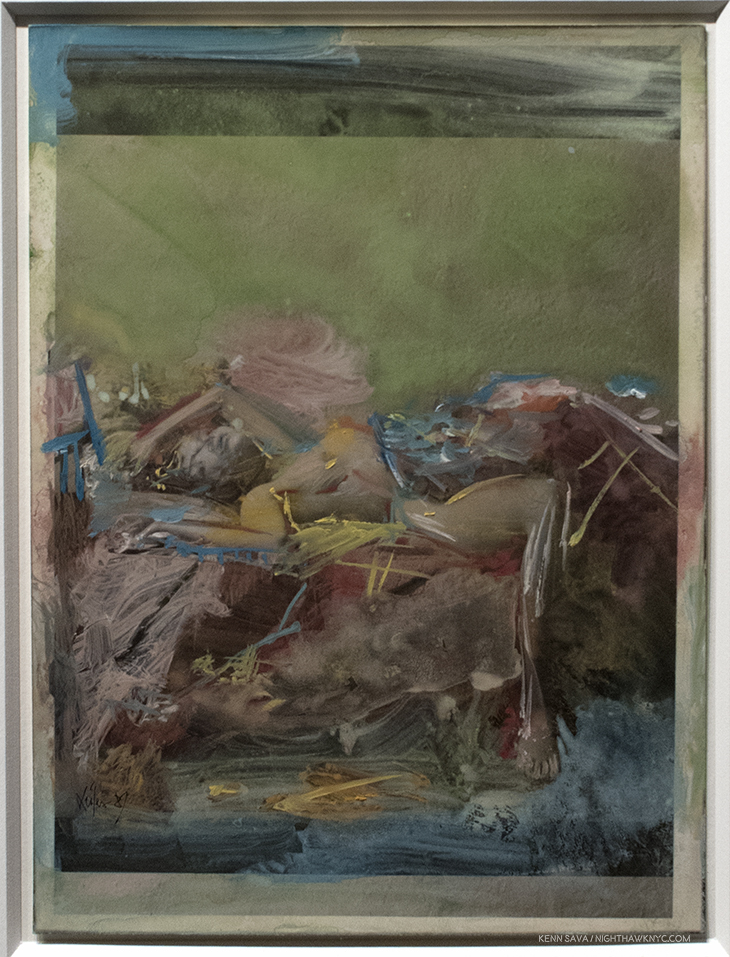
Untitled, 1987. Unprecedented. About as abstract as anything the Abstract Expressionists were doing, but with a Photo added.
Of the group on view at Howard Greenberg, I find the best of these works to be terrific and they left me longing to see Saul Leiter’s “other” Paintings that are not done on top of Photographs. They may well be yet another body of Saul Leiter’s work that has gone under-appreciated for too long. Wouldn’t that be something if Saul Leiter turned out to be a great Photographer AND a great Painter?
At the moment, Saul Leiter has rapidly been ascending to his rightful place as one of the Master Photographers of the 20th Century. Having been forgotten for decades of his life, it now seems highly unlikely the world will forget Saul Leiter again.
BookMarks-
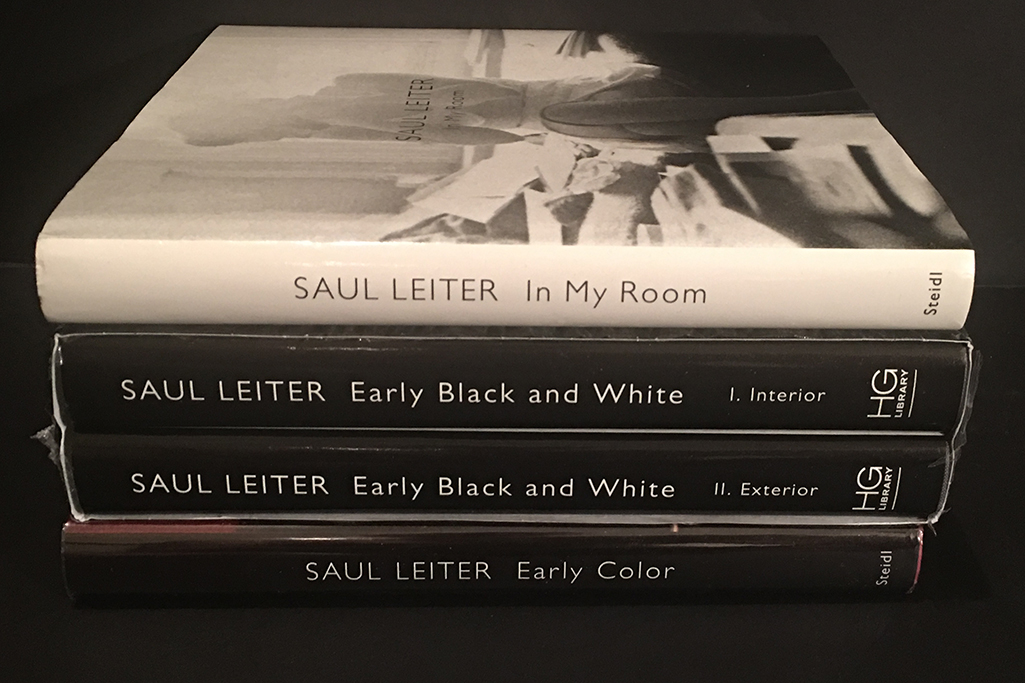
Steidl’s series of books share the same book design as Early Color, which was done by Martin Harrison. If it ain’t broke…
“Saul Leiter: Early Color” is the place to start exploring the work of Saul Leiter. Just reissued in its 8th edition, in my view, it is one of the “must have” PhotoBooks released thus far this century. For a wider view of his work, pairing “Early Color,” with Steidl’s “Saul Leiter: Early Black and White
” provides a good overview of his non-commercial Photography- at least as far as his large body of his work has been reintroduced to us thus far, especially while the latter is still in print. To supplement these, “Saul Leiter – All About Saul Leiter (Japanese and English Edition)
,” the catalog for a Retrospective in Japan last year, is a gorgeous, small, 300 page volume. Rumor has it that it is to be released in the USA later this year, but the original edition was named one of the 3 best PhotoBooks of the year by no less than Photographer Todd Hido. Two other retrospectives of note are much harder to find, especially at cheaper prices- Saul Leiter
(Retrospektive/Retrospective published in 2012 by Kehrer Verlag is a 300 page volume that’s a full 9 by 10 inches. Second, there is the catalog for the show at the Henri Cartier-Bresson Foundation they co-published with Steidl in 2008, simply titled Saul Leiter
. At 150 pages it’s a smaller retrospective, but benefits from a beautiful Steidl production. Finally, Saul Leiter: In My Room
offers the best look we’re likely to get at Saul Leiter’s “intimate” work and nudes. Just published by Steidl, it includes 81 Photos, with only a few previously seen in Early Black & White. It’s far and away the most intimate and personal collection of Saul Leiter’s work. For the rest of us, who didn’t know these women, it’s something of a classic of the unguarded moment, filled with marvelously unconventional poses and compositions. It fills out our picture of Saul Leiter’s accomplishment, adding a very personal group of works that held a very special place in his life to those, largely impersonal work seen previously. It is another book that will surprise and enthrall his growing number of fans. Finally, Painted Nudes
, published by Sylph Editions in 2015 is something of a sleeper. To date, it is the only book length collection of his Painting thus far released. Consisting of black & white prints of nudes from the “intimate” series the Artist then hand Painted, as I said above, it leaves me yearning to see more of his Painting.
Regarding Ernst Haas, Color Correction is out of print and fine copies are trading for hundreds of dollars on the secondary market. However, if you look hard, there’s a little known French edition that’s still in print and available for about $60. I’ve compared them and they contain the same images, the same number of pages, but the introduction and the essay are in French. Steidl is about to release a new book, Ernst Haas: Abstrakt, which will include 118 of his abstract images and so is certainly a book anyone interested in Mr. Haas should check out.
*-Soundtrack for this Post is “In My Room,” by the Beach Boys, which they wrote during the time Saul Leiter was taking his “intimate” Photos, as performed by the amazing Jacob Collier -an Artist who created this entire recording in his room!
My thanks to Monika Condrea and Steidl.
NighthawkNYC.com has been entirely self-funded and ad-free for over 6 years, during which over 250 full length pieces have been published. If you’ve found it worthwhile, you can donate to keep it going & ad-free below. Thank you!
Written & photographed by Kenn Sava for nighthawknyc.com unless otherwise credited.
To send comments, thoughts, feedback or propositions click here.
Click the white box on the upper right for the archives or to search them.
For “short takes” and additional pictures, follow @nighthawk_nyc on Instagram.
Subscribe to be notified of new Posts below. Your information will be used for no other purpose.
- “Saul Leiter,” 2008 Co-published by Steidl and the Foundation Henri-Cartier Bresson ↩
- from 1947-61, when he was succeeded by John Szarkowski, who went on to be a major shaper of the world of modern Fine Art Photography, and who he selected for the post. ↩
- Saul Leiter is barely mentioned in Joel Meyerowitz & Colin Westerbeck’s Bystander: A History of Street Photography,” Joel Meyerowitz is, also, a Photographer who worked with color early on, beginning in 1962. ↩
- Saul Leiter quoted in the introductory video on saulleiterfoundation.org ↩
- “My favorite Painter is Vermeer,” Saul Leiter: I just want to be left alone, Published 2015, Interview with Sebastian Piras in 2009 ↩
- “Saul Leiter Photographs and Works on Paper, Gallery Fifty-One, P.3 ↩
- Including a fascinating series of Diane Arbus in 1970, in her own space, that (not nude) have an intimacy akin to that seen in these works. ↩
- School of Visual Arts interview, 2013 ↩

